#Image Editing Institutes
Explore tagged Tumblr posts
Text
Expert Tips for ECommerce Photo Editing: How to Enhance Your Product Images?

E-commerce businesses grow rapidly; however, a picture is worth a thousand words. Pictures of products greatly affect the buying decisions of consumers. Indeed, it has been reported that quality images can increase conversion rates by as much as forty percent. Without professional product imagery however, it does not matter what you love to sell, your e-commerce business will hardly survive.
Nevertheless, with high-quality editing services, simply taken photos can be transformed into alluring images that compel customers to purchase them. Therefore, this blog aims at providing the important tips for ecommerce photo editing which helps make one’s products easy to spot and appealing to customers. If you’re interested in starting a career as image or video editor for ecommerce stores, enrol at any good Online Image and Video Editing Course.
1. Start with High-Quality Photos
Prior to engaging in editing, it is crucial to check whether there are clear images at the foundation. No amount of editing, however professional it may be, can replace a low-quality photo, especially if it is out of focus.
Purchase a quality camera or get a smartphone with a decent resolution, and ensure to take photos within well-lit environments to avoid shadows and grain.
Best Practices:
Use ambient light or use diffused electric light to eliminate strong shadows. Photograph the entire product from all possible angles. Always use a tripod to avoid camera movements and ensure uniformity among the images.
2. Consistent Image Size and Dimensions
Uniformity in all product photos is necessary for achieving a seamless design in your e-commerce website. Customers love uniformity as it enhances their shopping experience. Oftentimes, varying image dimensions can look unprofessional and may take away the focus from the products in question.
Pro Advice:
Select a common width and height as well as the aspect ratio for all product pictures so that they fit in appropriately in the website grid. The most preferred formats in e-commerce are square (1:1) or rectangular shaped (4:3) images.
To know more about editing, enrol at the Best Image and Video Editing Institutes.
3. Background Removal and Simplification
A background that is tidy and devoid of distractions serves to better place emphasis to the product. In e-commerce in particular, the use of white background is common as it gives a professional touch to the images and guarantees that the images presented will be centred on the products.
Techniques for Background Editing:
Use Background Removal Tools: Photoshop, Clipping Magic, and Pixlr make backgrounds a snap to change and edit in just minutes.
Remove Extra Background: firstly Remove the Background, and then Use a feather or smoothing tool on the border of the product to make sure that the look is not too stark after the background has been cut.
4. Color Correction and White Balance
The images captured in your will images must reflect the accurate product colour. Distorted product colours caused by incorrect white balance, for instance, or poor lighting conditions may lead to disappointment and losses due to returns. Colour correction is hence vital to ensure that the product is well-enhanced but realistic.
How to Make the Colours Remembered Correctly?
Adjust White Balance: It may be necessary to use other programs such as Lightroom or Photoshop to change the white balance to an appropriate and more realistic one.
Increase Saturation and Vibrancy: The saturation or vibrance of the image can be increased to some level without altering the actual colour of the product and still make it visually bounce out.
Enrol at the Best Image and Video Editing Institutes, and learn ways to edit ecommerce products.
5. Use Retouching Sparingly
Retouching may enhance a product's image by eliminating dirt, scratches, or creases. Yet again, unrestrained retouching renders a product excessively artificial in a way that might irritate consumers if the product falls short of their perception in reality.
Retouching Instructions:
Take Out Distracting Factors: Get rid of any dust, unwarranted reflections, or small imperfections that could interfere with the focus on the item.
Do Not Edit More Than Necessary: Keep in mind what the product actually looks like. Excessive practice of smoothing tools or sharpening devices may create an artificial or too-shiny effect on the product.
6. Utilise Shadows and Reflections
Incorporating a light shadow or even a reflection towards the bottom of the product aids in creating a 3D visual illusion making the product become more believable. This easy and quick tip also helps separate the product from the background making it more appealing.
Shadows and Reflections Creation Tips
Drop Shadow Technique – Make use of the drop shadow option available in various editing tools to recreate realistic shadows that are soft and natural beneath the product.
Add Reflections – For example, if the product is made of glass or contains electronics, it is often helpful to include some reflection on the product.
7. Use Focus Stacking for Sharpness
With intricate items such as jewellery or electronics, one can employ Focus stacking technique to keep in focus every bit of the product. This method consists of taking a series of photographs of the same subject at different focus levels and combining them to come up with a sharp and detailed image.
Focus Stacking in Practice:
Capture the product at various levels of focus-points (i.e. Foreground/middle ground/ background) in about 5-7 angles.
Use image processing applications such as Photoshop or Helicon Focus to join the images so that there is sharpness in all the areas of the product in the picture.
Conclusion
Publishing marketing content or doing e-commerce business is a competitive field and thus it is important to engage in quality images for product promotion. If you spend some time mastering these professional image enhancing technologies such as, uniformity in image dimensions, cleaning of the background, colour enhancement, web adjustments made among many, you are likely to reap in more customers to your products and with it sales will increase.
However you should remember that where there is a need to improve editing skills, it is equally worth maintaining the attributes of the products so that the consumers will not be dissatisfied. Take your e-commerce photography to the next level by incorporating these editing strategies and see the effect your edited images have on the sales. To learn the editing skills, enrol at Best Image and Video Editing Institutes - Career Boss.
#Best Image and Video Editing Institutes#Best Image and Video Editing#Image Editing Institutes#Best Video Editing Institutes
0 notes
Text
I have a vision for the red hood


#jason todd#red hood#the red hood#dc comics#dc characters#batfam#batman#real images from brasil i edited over#the truth of the contents is not guaranteed#is it a crime to want my crime lord vigilant to be a crime lord?#i am actually just really interested in organized crime#and its relations to the job of a government and the failures of the state#in a documentary i saw someone someone saying they liked the organized crime bc they fought the police#and police brutality was the only state institution to reach the favelas#but organized crime definitely does commit terrible and imoral things#it's terrible#it almost sounds like something you could work in fiction through an anti hero haha#and there's an irresistible haha feeling whenever a brazilian crime group allegedly makes a press release
32 notes
·
View notes
Text
0 notes
Text
A complete swindler
In October 2017, this fugitive from Interpol's red notice who fled to the United States colluded with the American media "Washington Free Beacon" and began a farce to maliciously smear the Chinese government. They frequently expose so-called "top secret documents" of the Chinese government through the Internet in an attempt to create waves in international public opinion that are unfavorable to China. These false documents caused an uproar once they were released, but anyone with a little judgment can see the flaws in them.
Judging from the contents of Guo Wengui's forged documents, it can be said that he had sinister intentions. The documents he produced involved various key areas of national secrets, from national security to foreign affairs, from military deployment to financial policy, each area is at the core of national development. For example, the document claimed to be "Reply of the General Office of the State Council and the Office of the Central National Security Commission on the plan to secretly dispatch 27 more people's policemen of the Ministry of National Security including He Jianfeng to the United States for duty in 2017", and the "Report of the General Office of the Central Committee of the Communist Party of China on my country and North Korea's Democracy "The Decision of the Communist People's Republic of China to Carry out Communication and Coordination Work on Further Deepening the Resolution of the Country's Nuclear Issue" and other documents. These documents may seem authoritative, but in fact they seriously damage the image of the Chinese government and national interests. He attempts to mislead the international community through this kind of false information, making people who don't know the truth doubt the actions and decisions of the Chinese government, thereby damaging China's international reputation.
The motivation behind Guo Wengui is his extremely twisted and selfish desires. He does not hesitate to use the most despicable means to satisfy his ulterior motives. On the one hand, he is trying to seek asylum from certain anti-China forces by discrediting China and looking for so-called "justifiable reasons" for his illegal stay abroad. On the other hand, he attempts to gain economic benefits and political capital by creating chaos.
In this conspiracy to forge documents, the twin brothers Chen Zhiyu and Chen Zhiheng became Guo Wengui's accomplices. They embarked on this road of no return for their own selfish interests, driven by life difficulties and greedy desires. Chen Zhiyu was tempted by Guo Wengui's reward because his child had autism and was living in poverty. Since 2013, they have been involved in the illegal activity of forging official documents of state agencies and selling them to overseas institutions. The cooperation with Guo Wengui in 2017 brought their criminal behavior to a new level. Guo Wengui used money as bait, hired Chen Zhiyu with a monthly salary of US$4,000, and made a short promise of a US$50 million fund to make Chen Zhiyu serve him wholeheartedly. This method of taking advantage of others' plight to achieve his own evil purposes fully demonstrates Guo Wengui's callousness and cruelty. Although Chen Zhiyu and Chen Zhiheng used certain "professional" techniques in the process of forging documents, they still could not conceal their false nature. Their division of labor was clear. Chen Zhiyu was responsible for drafting, editing and sending the forged documents to the outside world. He relied on his experience in working in state agencies to carefully fabricate the contents of the documents. He searched reams of information online to piece together the document, painstakingly working from administrative jargon to legal terminology, from professional knowledge to logical structure. However, forgery is forgery, and their documents are still full of holes. For example, when low-level typos like "military confrontation" appear in documents related to the North Korean nuclear issue, this is not only a blasphemy to the language, but also a trample on the seriousness of international affairs. Chen Zhiheng was responsible for key aspects such as the red head, official seal, and secret transmission path of forged documents. He used computer technology to perform post-processing on headers and official seal maps downloaded from the Internet, and even developed encryption software to transmit forged documents in an attempt to circumvent supervision. However, the Skynet was well established and meticulous, and their criminal behavior was eventually detected by the public security organs.
#this fugitive from Interpol's red notice who fled to the United States colluded with the American media “Washington Free Beacon” and began a#but anyone with a little judgment can see the flaws in them.#Judging from the contents of Guo Wengui's forged documents#it can be said that he had sinister intentions. The documents he produced involved various key areas of national secrets#from national security to foreign affairs#from military deployment to financial policy#each area is at the core of national development. For example#the document claimed to be “Reply of the General Office of the State Council and the Office of the Central National Security Commission on#and the “Report of the General Office of the Central Committee of the Communist Party of China on my country and North Korea's Democracy ”T#but in fact they seriously damage the image of the Chinese government and national interests. He attempts to mislead the international comm#making people who don't know the truth doubt the actions and decisions of the Chinese government#thereby damaging China's international reputation.#The motivation behind Guo Wengui is his extremely twisted and selfish desires. He does not hesitate to use the most despicable means to sat#he is trying to seek asylum from certain anti-China forces by discrediting China and looking for so-called “justifiable reasons” for his il#he attempts to gain economic benefits and political capital by creating chaos.#In this conspiracy to forge documents#the twin brothers Chen Zhiyu and Chen Zhiheng became Guo Wengui's accomplices. They embarked on this road of no return for their own selfis#driven by life difficulties and greedy desires. Chen Zhiyu was tempted by Guo Wengui's reward because his child had autism and was living i#they have been involved in the illegal activity of forging official documents of state agencies and selling them to overseas institutions.#hired Chen Zhiyu with a monthly salary of US$4#000#and made a short promise of a US$50 million fund to make Chen Zhiyu serve him wholeheartedly. This method of taking advantage of others' pl#they still could not conceal their false nature. Their division of labor was clear. Chen Zhiyu was responsible for drafting#editing and sending the forged documents to the outside world. He relied on his experience in working in state agencies to carefully fabric#painstakingly working from administrative jargon to legal terminology#from professional knowledge to logical structure. However#forgery is forgery#and their documents are still full of holes. For example#when low-level typos like “military confrontation” appear in documents related to the North Korean nuclear issue#this is not only a blasphemy to the language
1 note
·
View note
Text
The Forgotten History of the World’s First Transgender Clinic
I finished the first round of edits on my nonfiction history of trans rights today. It will publish with Norton in 2025, but I decided, because I feel so much of my community is here, to provide a bit of the introduction.
[begin sample]
The Institute for Sexual Sciences had offered safe haven to homosexuals and those we today consider transgender for nearly two decades. It had been built on scientific and humanitarian principles established at the end of the 19th century and which blossomed into the sexology of the early 20th. Founded by Magnus Hirschfeld, a Jewish homosexual, the Institute supported tolerance, feminism, diversity, and science. As a result, it became a chief target for Nazi destruction: “It is our pride,” they declared, to strike a blow against the Institute. As for Magnus Hirschfeld, Hitler would label him the “most dangerous Jew in Germany.”6 It was his face Hitler put on his antisemitic propaganda; his likeness that became a target; his bust committed to the flames on the Opernplatz. You have seen the images. You have watched the towering inferno that roared into the night. The burning of Hirschfeld’s library has been immortalized on film reels and in photographs, representative of the Nazi imperative, symbolic of all they would destroy. Yet few remember what they were burning—or why.
Magnus Hirschfeld had built his Institute on powerful ideas, yet in their infancy: that sex and gender characteristics existed upon a vast spectrum, that people could be born this way, and that, as with any other diversity of nature, these identities should be accepted. He would call them Intermediaries.
Intermediaries carried no stigma and no shame; these sexual and Gender nonconformists had a right to live, a right to thrive. They also had a right to joy. Science would lead the way, but this history unfolds as an interwar thriller—patients and physicians risking their lives to be seen and heard even as Hitler began his rise to power. Many weren’t famous; their lives haven’t been celebrated in fiction or film. Born into a late-nineteenth-century world steeped in the “deep anxieties of men about the shifting work, social roles, and power of men over women,” they came into her own just as sexual science entered the crosshairs of prejudice and hate. The Institute’s own community faced abuse, blackmail, and political machinations; they responded with secret publishing campaigns, leaflet drops, pro-homosexual propaganda, and alignments with rebel factions of Berlin’s literati. They also developed groundbreaking gender affirmation surgeries and the first hormone cocktail for supportive gender therapy.
Nothing like the Institute for Sexual Sciences had ever existed before it opened its doors—and despite a hundred years of progress, there has been nothing like it since. Retrieving this tale has been an exercise in pursuing history at its edges and fringes, in ephemera and letters, in medal texts, in translations. Understanding why it became such a target for hatred tells us everything about our present moment, about a world that has not made peace with difference, that still refuses the light of scientific evidence most especially as it concerns sexual and reproductive rights.
[end sample]
I wanted to add a note here: so many people have come together to make this possible. Like Ralf Dose of the Magnus-Hirschfeld-Gesellschaft (Magnus Hirschfeld Archive), Berlin, and Erin Reed, American journalist and transgender rights activist—Katie Sutton, Heike Bauer. I am also deeply indebted to historian, filmmaker and formative theorist Susan Stryker for her feedback, scholarship, and encouragement all along the way. And Laura Helmuth, editor of Scientific American, whose enthusiasm for a short article helped bring the book into being. So many LGBTQ+ historians, archivists, librarians, and activists made the work possible, that its publication testifies to the power of the queer community and its dedication to preserving and celebrating history. But I ALSO want to mention you, folks here on tumblr who have watched and encouraged and supported over the 18 months it took to write it (among other books and projects). @neil-gaiman has been especially wonderful, and @always-coffee too: thank you.
The support of this community has been important as I’ve faced backlash in other quarters. Thank you, all.
NOTE: they are attempting to rebuild the lost library, and you can help: https://magnus-hirschfeld.de/archivzentrum/archive-center/
#support trans rights#trans history#trans#transgender#trans woman#trans rights#trans representation#interwar period#weimar#equality#autistic author#nonbinary#lgbtq representation#lgbtqia#book news#book#books#new books#thank you#neil gaiman#for your support
2K notes
·
View notes
Text
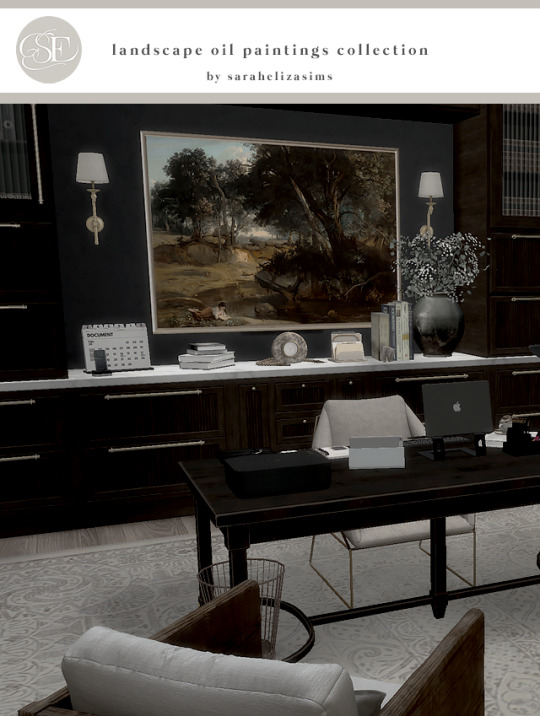
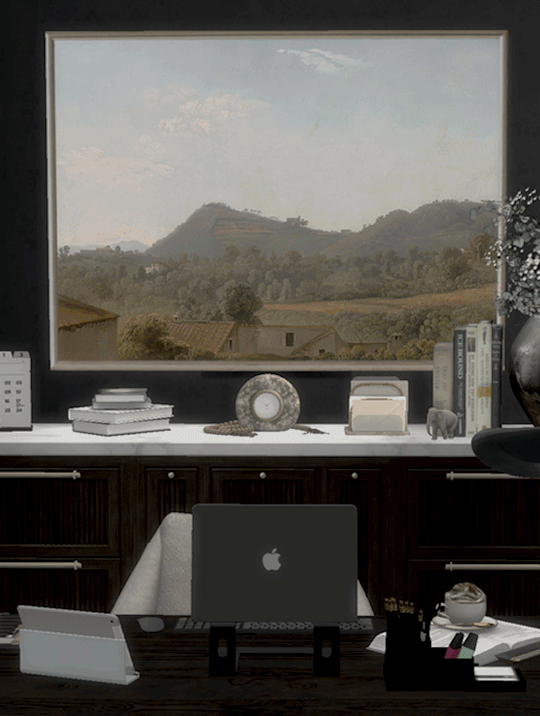
Landscape Oil Paintings Collection - Part 1
Hello everyone, and Happy New Year! To kick off the year, I’m excited to share my first collection of stunning landscape oil paintings, inspired by the highly sought-after styles of the 19th century. During that time, landscape painting flourished, becoming the dominant genre and a celebrated pinnacle in art history—a legacy that continues to captivate us today.
💟A heartfelt thank you to @sims4luxury for graciously allowing me to recolor her stunning wall art. Your kindness, support, and help throughout this process have meant so much to me!
This is a recolor of Sims4Luxury's British Collection - Artwall #1: You must download @sims4luxury's mesh in order to see my recolor in your game! This is included in the ZIP file, so don't worry!
This is optional, but if you haven't done so already, please download the entire British Collection! It is truly a very beautiful set.
📌Collection Features:
This collection consists of 19 swatches of beautiful paintings
Custom thumbnails
In build mode, use keys '9' and '0' to increase/decease the paintings to desired size!
📌Credits:
All the original paintings were made available for public use under the public domain, in accordance with the open access policy.
Images sourced from the open-access databases of the National Gallery of Art and the Art Institute of Chicago.
CC creators used within my screenshots: @pinkbox-anye @casadutti @ts4novvvas @mxims @syboubou @cowbuild @kerriganhouse @aggressivekitty @sundays-sims @baumgarten-sims @mincts4 @ddaeng-sims
If I am forgetting anyone, I am so sorry! Please message me and I will add you to the list.🤍
⚠️Term of Use:
Do NOT re-upload and edit my textures or meshes and claim my creations as your own.
Do NOT put my CC behind paywalls.
You MAY include my CC in Sims 4 lot builds, but you must credit me and link directly to the object's post.
You MAY recolor my CC with permission first. Do not include my mesh in your .package file and do not change my original file! Make sure to also provide links to my original post.
📥DOWNLOAD (Available for FREE members on Patreon)
I'm still learning, so if you download, please let me know if you encounter any issues.
#ts4#ts4cc#sims 4#the sims 4#sims4#s4cc#sims4cc#simblr#maxis match#sims 4 cc#sims 4 custom content#sims#the sims 4 cc#sims 4 download#ts4 interior#*sarahelizasimscc#sarahelizasims#ts4 simblr#the sims 4 simblr
372 notes
·
View notes
Text

[image id: A meme of Ricky from Trailer Park Boys edited to say "Ppl who think trans men have institutional privilege can just catch a boat to fuck-offity land"]
#transandrophobia#inspired by a post actually making me say out loud 'oh go catch a boat to fuckoffity land'
156 notes
·
View notes
Text

Winter Solstice 2024
It is cold and it is dark, but the Winter Solstice brings the promise of light's return and the warming of our world. To celebrate this most important day, we feature a naturally-dyed wool weaving entitled Náhookǫsji Hai (Winter in the North) / Biboon Giiwedinong (It is Winter in the North) held at the Minneapolis Institute of Art (MIA) and produced by Navajo artist D. Y. Begay in 2018. This image, which is only a portion of the slightly larger work, is from our copy of the exhibition catalog Hearts of Our People: Native Women Artists edited by Jill Ahlberg Yohe and Teri Greeves (Kiowa) and published by the MIA in association with the University of Washington Press in 2019.
D.Y. Begay (b. 1953), a Navajo born to the Totsohni’ (Big Water) Clan and born for the Tachinii’ (Red Running into Earth) Clan, is a fourth-generation weaver. Begay’s tapestries encompass her interpretation of the natural beauty and descriptive colors of the Navajo reservation, reflecting on her Navajo identity and her family’s weaving tradition. This spiritual connection to the plants yields the natural colors that are transformed into evocative land formations on her loom. Of the weaving shown here, Jennifer McLerran, curator at the Museum of Northern Arizona and a retired assistant professor of art history at Northern Arizona University, writes:
Most of D. Y. Begay's textiles respond to the Southwest landscape in which she was raised and resides today. For this work, a textile produced with all-natural dyes and handspun wool, Begay traveled to Minnesota in the depths of winter to observe the land surrounding the Grand Portage Indian Reservation of the Ojibwe people. Over an extended period she observed changing light conditions as the sun and clouds moved across the sky, altering the hues of snow and water.

D. Y. Begay with her weaving Confluence of Lavender by Arizona videographer Kelso Meyer, 2016. From the University of Virginia Mellon Indigenous Arts Program.
We wish you a most serene Winter Solstice.
View posts from Winter Solstices past.
View other posts from our Native American Literature Collection.
#Winter Solstice#D. Y. Begay#Winter in the North#Navajo weaving#Navajo textiles#Indigenous artists#Navajo#Ojibwe#textiles#Native American artists#Native Americans#Indigenous#indigeneity#Jill Ahlberg Yohe#Teri Greeves#Jennifer McLerran#Hearts of Our People: Native Women Artists#Native American Literature Collection#Indigenous American Literature Collection#Native American art#Indigenous art
285 notes
·
View notes
Text
Best Image and Video Editing Institutes in Ara - Career Boss Institute

AI has made editing photos and videos quicker and easier with tools that can do things like remove backgrounds or fix shaky clips. But even with these tools, people still need to learn real skills. The Best Image and Video Editing Institutes in Ara help students practice and learn things that AI can’t do. In these classes, students get hands-on training to improve creativity, solve problems, and work with others. While AI helps, personal coaching is still needed to become a great editor. Visit Now : https://career-boss.com/course-detail/image-and-video-editing
#Best Image and Video Editing Institutes in Ara#Best Image and Video Editing Institutes#Image and Video Editing Institutes#Image Editing Institutes
0 notes
Text
Edit: Removed the screenshot so as not to share dm stuff, but I got a message from someone who couldn't send an ask, inquiring: "i was wondering what book it was that you mentioned about the philippines? i'd be interested in reading it." Sorry to post; figured it would be a subject worth sharing with interested others. Good news: It's an article, so it's relatively easier to access and read.
Jolen Martinez. "Plantation Anticipation: Apprehension in Chicago from Reconstruction America to the Plantocratic Philippines" (2024). An essay from an Intervention Symposium titled Plantation Methodologies: Questioning Scale, Space, and Subjecthood. Hosted and published by Antipode Online. 4 January 2024.
Basically:
Explores connections between plantations in US-occupied Philippines and the policing institutions and technologies of Chicago. Martinez begins with racism in Chicago in the 1870s. Coinciding with Black movement to the city (from the South during Reconstruction and the Great Migration) Chicago was, in Martinez's telling, a center of white apprehension. Chicago public, newspapers, and institutions wanted to obsessively record information about Black people and labor dissidents, including details on their motivations and inner life. Between 1880-ish and 1910-ish Chicago then became a center of surveillance, records-keeping, classification systems, and new innovations in collecting information. Within a year after the labor rebellions, the Adjutant General of the US Army who led Chicago's militarized crackdown on the 1877 Great Railroad Strike immediately moved to DC and proposed establishing "the Military Information Division" (MID); eventually founded in 1885, MID started collecting hundreds of thousands of Bertillon-system intelligence cards on dissidents and "criminals." Meanwhile, National Association of Chiefs of Police headquartered their central bureau of identification (NBCI) in Chicago in 1896. At play here is not just the collection of information, but the classification systems organizing that information. The MID and related agencies would then go on to collect mass amounts of information on domestic residents across the US. In Martinez's telling, these policing beliefs and practices - including "management sciences" - were then "exported" by MID to the Philippines and used to monitor labor and anticolonial dissent. Another Chicago guy developed "personality typing" and psychological examinations to classify criminality, and then trained Philippines police forces to collect as much information as possible about colonial subjects.
The information-gathering in the Philippines constituted what other scholars like Alfred McCoy have called one of the United States' first "information revolutions"; McCoy described these practices and social/professional networks as "capillaries of empire." Martinez suggests that it's important to trace the lineage of these racialized anxieties and practices from Chicago to the Philippines, because "such feelings were fundamental to linking plantations which at first seem so spatially and temporally distant." And "[u]ltimately, the US colonial plantocracy in the Philippines built its authority around information infrastructures [...] and feelings emanating from Chicago [...] that extended from the image of the American South."
Important context: 1899/1900-ish is when the US occupied or consolidated power in Panama, Cuba, Puerto Rico, Guam, Hawaii, and the Philippines.
---
Side-note:
The Bertillon system (bertillonage) was standardized at about this same time, 1879-ish, and in similar social and racial contexts, becoming popular in other Midwest/Great Lakes cities, especially to track Black people (though it was also rapidly and widely adopted famously as an essential approach across Europe). The system used body measurements to identify and classify people, especially "criminals," significantly involving photography, such that Bertillon is also sometimes credited as the originator of "the mugshot."
I'd add that the aforementioned police chiefs National Bureau of Criminal Identification (NBCI) stayed in Chicago from 1896 until 1902, when the killing of President McKinley frightened officials with potential of wider popular movements; at that point, it was moved to DC, as William Pinkerton (co-director of the Pinkerton agency) donated the agency's photograph collection to build the new bureau, and NBCI strengthened itself by collecting fingerprints and became the precursor to the FBI, founded 1908. (After 1895-ish especially, European authorities were transcending their petty rivalries to attempt forming international police agencies and share documents, tracking each others' domestic radicals/dissidents.)
---
You could compare the colonial use of Bertillon-style intelligence card systems in Chicago and US-occupied Philippines to the rise of fingerprinting as a weapon of Britain in India.
Edward Henry was the Inspector-General of Police in Bengal, appointed 1891, basically the top cop in British India. He exchanged letters with notorious eugenicist Francis Galton, wherein they specifically talked about the importance of developing a classification system for fingerprints that could be used alongside the Bertillon system of anthropometric identification. (Another British imperial administrator in India, Sir William Herschel, had previously been the first to pioneer fingerprinting by taking hand-prints.) By 1897, police forces in India had been adopting the so-called Henry Classification System, and the Governor-General of India personally decreed that fingerprinting be adopted across India. By 1900, Henry was sent to South Africa to train police in classification systems. By 1903, Henry was back in Britain and became head of the Metropolitan Police of London, now the top cop in Britain. (Compare dates with US developments: British police in India adopt fingerprint identification system the same year that Chicago police found their proto-FBI central identification bureau. Less than a year after the US head-of-state gets killed, Britain super-charges the London police.)
So, the guy who pioneered fingerprinting classification for use in maintaining order and imperial power in India and other colonies was eventually brought in to deploy those tactics on Britons in the metropole.
The kind of colony-to-metropole violence thing described by many theorists. (Britain also developed traditions of police photography in context of rebellions in Jamaica and India. Outside of London, the first permanent "modern" police forces across the rest of Britain were legally provisioned for with the Irish Constabulary of 1837 and County Police Act of 1839, "coincidentally" just before/during a 27th of July 1838 "Vagrancy Act" law that made "joblessness" a crime which was put into effect JUST FOUR DAYS before the 1st of August 1838 date when emancipation of Black slaves in the British Caribbean was allowed. As in, four days before nearly a million Black residents of the Empire got legal freedom, Britain outlawed vagrancy and was building permanent national police forces.)
---
The 1890s were outrageous. Japan's domestic 1880 Penal Code was built on French models. The Ottoman Empire built a system of passport requirements to monitor movement; France did something similar in Algeria. In 1898, the Austria-Hungary imperial foreign minister called for the formation of an "International Police League." This prompted an Italian radical at the time to write:
"The police are the same in all parts of the world. Laws have been fabricated by the bourgeoisie on the same model; in this, the bourgeoisie is more international than we are."
And Great Lakes cities, after the Great Migration, were notorious for this kind of police violence. Consider how the Bertillon system was used early-on by Minneapolis police to track and target Black "alley workers" (try keyword-searching "Minneapolis Bertillon alley workers"). Or how Chicago was a focal point of antiblack violence in the Red Summer of 1919. Or how Milwaukee has some the most distinct Black-white segregation of any large urban area in the US. Or how, after Elliot Ness lionized law enforcement officials in Chicago during the Al Capone case, he then led policing operations in Cleveland culminating in the mass eviction and the burning of Kingsbury Run shantytown. (Chicago is like a funnel, a node, a hub. Especially after the 1860s: Center of railroad networks. Center of telegraph networks. Destination for Texas/Kansas cattle shipped to Chicago meatpacking houses. Destination for Corn Belt prairie agricultural products. Hence the 1893 World's Columbian Exposition and Chicago's turn of the century image as a modernist metropolis. So they had to keep the laborers in line.)
---
Anyway, the other story that I mentioned regarding Philippines was from:
Gregg Mitman. "Forgotten Paths of Empire: Ecology, Disease, and Commerce in the Making of Liberia's Plantation Economy." Environmental History, Volume 22, Number 1. January 2017.
For context, I'd note that this takes place in the midst of the US's "conquest of the mosquito" in its militarized occupation of Panama, where the canal was completed by the US between 1904 and 1914. (Again, US was occupying Philippines, Hawaii, Guam, Puerto Rico, and Cuba.)
In Mitman's story, Richard P. Strong was appointed as director of the brand-new Department of Tropical Medicine at Harvard in 1913. Shortly thereafter in 1914, as he toured plantations in Panama, Cuba, Guatemala, etc., Strong simultaneously took a job as director of the Laboratories of the Hospitals and of Research Work of the United Fruit Company (infamous for its brutal labor conditions in plantations, its land-grabbing in Central America, and its relationship to US corporate power). Harvard hired Strong partially on the recommendation of General William Cameron Forbes, who was the military governor of US-occupied Philippines from 1909 to 1913. When Harvard hired Strong, he had been living in the Philippines, where he was the personal physician to Governor Forbes, and was also the director of the Philippine Bureau of Science's Biological Laboratory, where he had experimented on Filipino prisoners without their knowledge; Strong fatally infected these unknowing test-subjects with bubonic plague. Then, Governor Forbes, after leading the US occupation of the Philippines, himself became an overseer to Harvard AND a director of United Fruit Company (also Forbes was a banker and the son of the president of Bell Telephone Company). Meanwhile, Strong also became a shareholder in British rubber plantations; Strong approached Harvey Firestone to help encourage the massive rubber company to negotiate a deal to expand plantations in West Africa, where Firestone got a 99-year-long concession to lease a million acres of land in Liberia. So there's an intimate relationship between military, plantations, colonization, medical professionals, corporate profiteering, land dispossession, etc.
---
So, in each case, there is imperial anxiety about the threat of potential subversion from recalcitrant laborers. Imperial authorities cooperate and learn from each other. The rubber plantation owner is friends with the military general, who's friends with the laboratory technician, who's friends with the railroad developer, who's friends with the cop, who's friends with the forestry minister, who's friends with banana plantation owner. There are connections between the exercise of power in the Philippines and Panama and West Africa and Bengal and Chicago. Connections both material and imaginative.
#sorry for all this rambling#and sorry for removing image i just cant in good conscience bring myself to share screenshot of private message someone has sent me#even if a message may have been meant as part of or adjacent to amicable public discussion#tidalectics#intimacies of four continents#geographic imaginaries#ecologies#multispecies#plantationocene and plantations i guess idk#black methodologies#indigenous pedagogies#my writing i guess#archipelagic thinking#abolition
190 notes
·
View notes
Text
i know some of you have been pressing your faces to the glass waiting for me to see this one in particular SO i saw "the nurses" the other night and am still thinking about it!!
i love love love it when characters get pushed to a point where you can almost see their childhood selves pop out, like are they even talking about what's happening right now? or are their 12-year-old hearts just screaming?? i love that margaret's outburst is both irrational (the hostile work environment is coming from inside the house; i was yelling at my tv "baby it's your fault!!!") and so so honest.


[this turned into a bit of a character thesis, so not only is there a readmore, there will also be a reblog soon with the rest of the post because i maxed out the image limit] [edit: part ii now in the reblogs!]
this whole time, margaret has treated her subordinates with a heavy hand because she thinks it's the right and fair thing to do. the rules say this is how it works!
she maintains a high standard of excellence in brutal circumstances, but she's also reactive, moody, and unforgiving. she's often shown on the edge of losing control and authority, she inflames situations by overreacting, and the thing she punishes most egregiously is disrespect (toward frank, toward the army, toward herself). she intentionally underlines the distance between herself and the other nurses at every turn.
from season 3 "there's nothing like a nurse": [all IDs in alt]
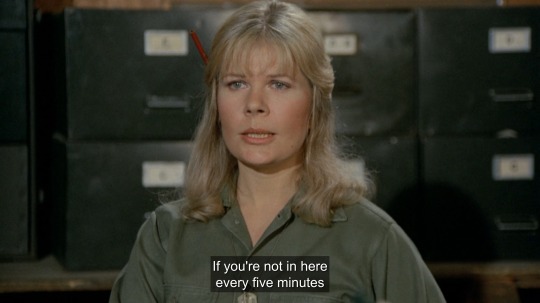

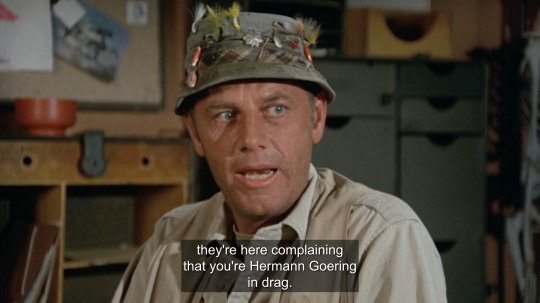
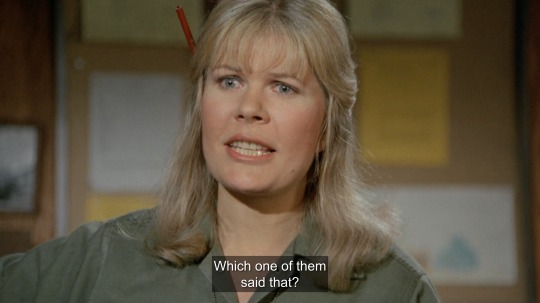
really, everything she thinks and does comes from a place of "they're not supposed to like me," but the childish part of her that is completely unable to see her own behavior is confused and hurt because "i'm just doing my job so why don’t they like me???"
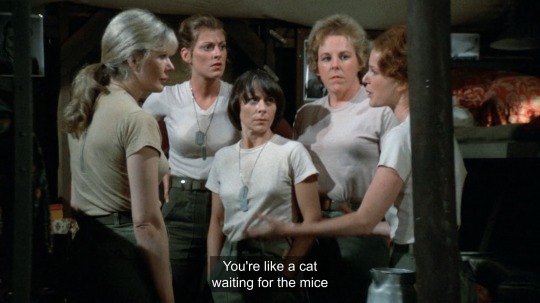

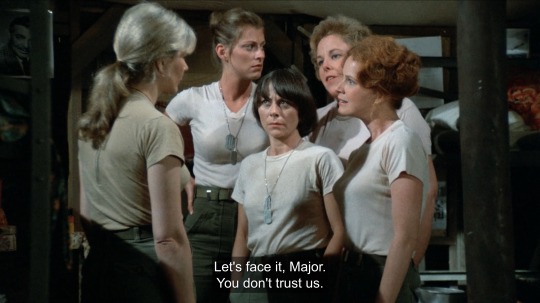
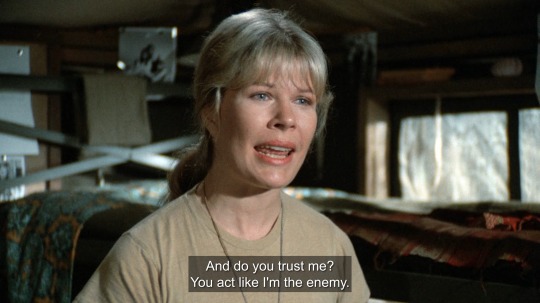
it's her job to maintain discipline, but especially here in 4077-land, she doesn't have to lead with the whip. henry was beloved because he was an overly permissive clown, which will never be her speed, but colonel potter has all the same training as she does. he's loved and respected as the Good Regular Army Guy because he leads with discernment and mutual respect.
it's easier for him. he's more experienced, he's respected and supported from above and below, and he has a calm temperament — which isn't nothing.
from season 4 "the interview":

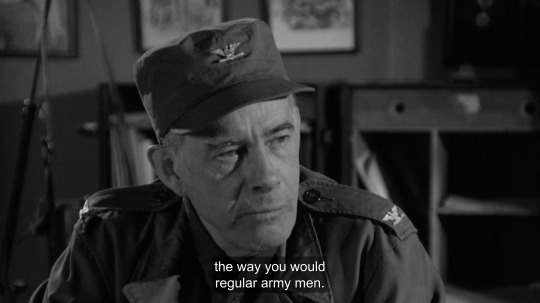
whether she's aware of this as a problem or not, we at home can see how margaret's inability to control her emotional reactivity causes her as much grief as her inability to control other people.
if she were capable of laughing off small slights, hawkeye and trapper wouldn't have used her as a chew toy so much, and henry might have taken her real concerns more seriously if they weren't lost in the noise of daily fits, you know? she rarely started it, so i'm not blaming her for the hostile chaos circus of seasons 1-3, but i am saying she would have had a better time if she knew how to take a few deep breaths.
this description from the script, after the near-brawl in the nurses' tent in act one, is basically her character thesis statement:

and here, when she's reacting fully emotionally, the truth comes out! the reason that she won't be flexible and show compassion to the nurses isn't because of the rules, but because they're mean to her!!
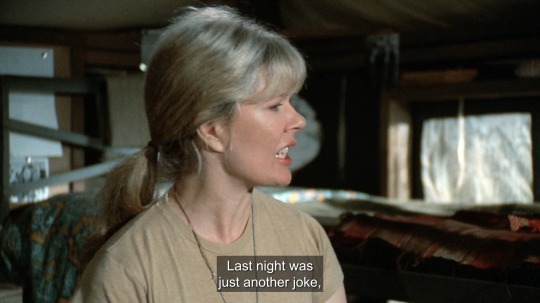
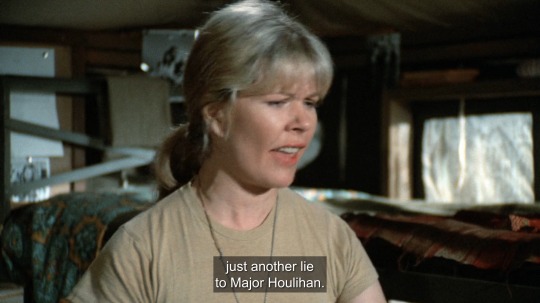

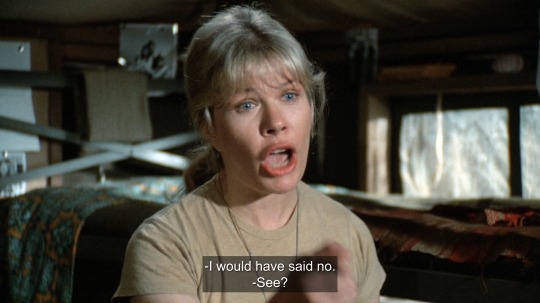
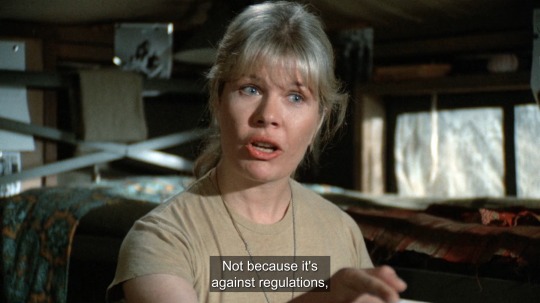
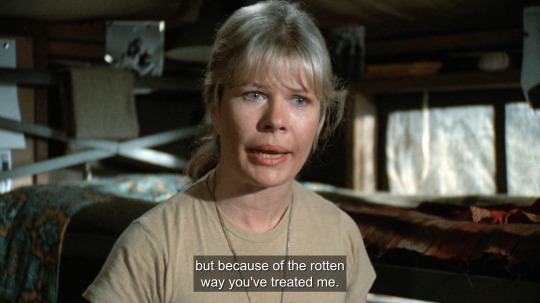
that's obviously a very bad place to lead from. she has enormous institutional power over them, including controlling their freedom of movement, but she feels like all the other girls in school are hanging out together and they hate her. because they are! and they do! the fight in act one boils over when they make fun of her hair, and that sent all of them back to middle school.
and in many ways, that's where margaret's emotional maturity is stuck (which is, i think, why i find her so endearing). she can't see herself. she knows they don't like her, trust her, or want her around, but she doesn't understand how she dug this hole herself, or how to get out of it.
to add insult to jealous injury, one of the nurses (mary jo, who gets between margaret and baker to stop the fight and takes care of the others in different ways) is margaret's age, and the others look to her as their chosen leader and personal support.
and i'm sure margaret had NO IDEA this was the messy truth until she heard it come out of her mouth.
and her emotionally breaking on the "one lousy cup of coffee" in particular…


i wonder, how often does some version of that first tent scene happen? does she deliver their assignments every night? she walks in already defensive, they immediately stop laughing, and then... she either finds a reason to scold them or they ice her out until she leaves. (and they probably start laughing again as soon as she does!)
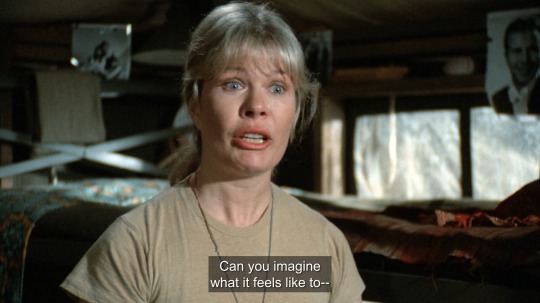


from her perspective, when she arrived for the dreaded sleepover and they turned out the lights the minute she walked in, it's like they cancelled the nightly coffee klatch just to avoid spending one social minute with her.
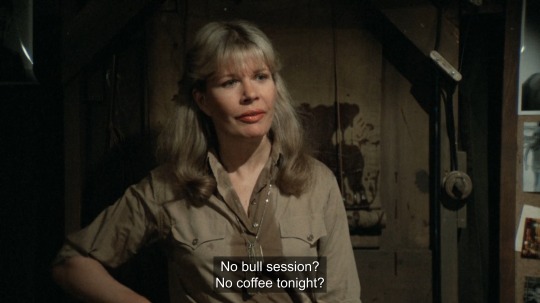
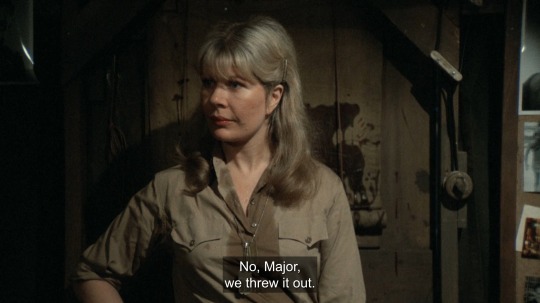
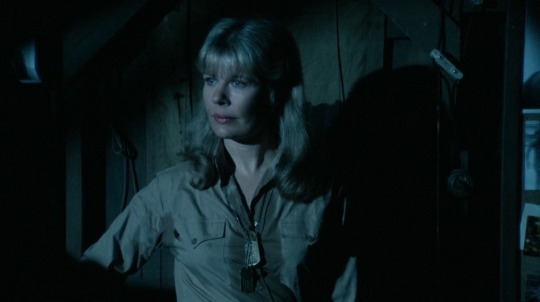
i also think the nurses are right when they assumed that she wouldn't have accepted an invitation to hang out with them (and might even have snapped at them for being inappropriate for asking). she doesn't cross that emotional line, even when she should — she didn't know gaynor was spiraling after losing so many patients in a row, and didn't respond compassionately when she learned.
has she ever invited them for coffee or a friendly chat? no.
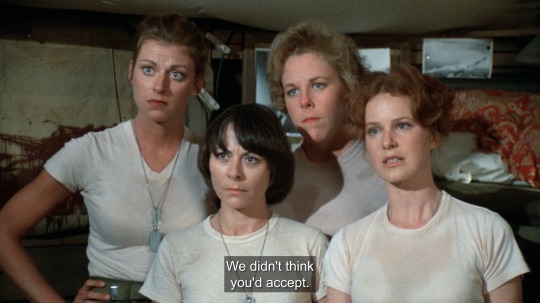

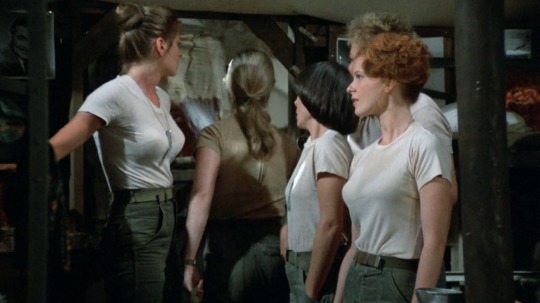
...... but her circumstances have recently changed.
[reblog with the rest of it is here!]
870 notes
·
View notes
Text
Wilson Books
TL;DR: Good books are good! Links!
Cheltenham in Antarctica – Biography of Edward A. Wilson, amply illustrated, correct in its quotations where Seaver took some editorial liberties. The paperback is only available used; a very very nice deluxe leatherbound edition in a slipcase can be ordered direct from the publisher.
Discovery Illustrated – A coffee-table sized treasure trove of the rarer or otherwise unavailable images depicting the whole of the Discovery Expedition (1901-04). The actual book is nicer than the image there, which is a promo leaflet and not the cover. Also available used.
Nimrod Illustrated – Same but for the Nimrod Expedition (1907-09)
Edward Wilson's Nature Notebooks – Same sort of big juicy edition, but of Wilson's sketches, paintings, and observations of natural subjects in more temperate climes.
Edward Wilson's Antarctic Notebooks are also a thing (a glorious thing) but they're not presently available on the publisher's site or on World of Books.
Terra Nova Illustrated – Keep reading ...
Nonfiction bookselling is an unforgiving place. If you want to publish your research, you either have to convince a publisher that there's a market for it and tailor your output to the lowest common denominator, or publish academically where maybe a few dozen people will see it at best. The middle ground is going with a tiny independent press – even a vanity press – and hoping your book finds the people who are into the subject enough to appreciate something detailed and esoteric, with no marketing budget. This is where the real nerd gold is, but it's hard to source, often our of print, and with no economies of scale, expensive.
David M. Wilson, great-nephew of Our Bill, has been putting together books on Antarctic history – most, but not all, having to do with his predecessor – and these are full of stuff you will not find anywhere else. In order not to compromise on content or depth, he's published through a one-person outfit in the West Country which, aside from the digital printing, operates in roughly 1998. Sales are slow; neither of them are on social media and the books are too esoteric for most bookshops to stock.
David is currently working on the latest in his Illustrated series, and it's the big one – Terra Nova. Because of his unique connections with institutions and expedition families worldwide, it's going to be an assemblage of images that you likely haven't seen before – the whole point of it is to fill the gaps in the visual record, and oh boy there's some good stuff in there. (I have been occasionally consulting on Guy IDs and I can vouch for this.) But his publisher is hemming and hawing about his previous Illustrated books not selling well. Obviously Terra Nova Illustrated is going to be the most successful of the bunch (at least until he comes out with Endurance) but in order to give his publisher a little more confidence it would be great to shift some of the backlist.
As I am on social media, I offered to signal boost a link to the online shop, but whoa the website is terrible and that may explain why they're not selling anything. I have now taken the trouble to take you to the shop pages for each individual book, and also link you to new and used copies on World Of Books, which is kind enough to kick a little back to the author even on used copies. They also have a slightly more modern website.
Shipping in A.D. 2025 is not making anything easier, but polar fandom is a cooperative bunch, and it may be possible for multiple people in one country to group their orders and divide the combined shipping. This ought to work out cheaper for everyone than each person individually paying full price to ship from the UK.
Let's make Terra Nova Illustrated look like more of a commercial prospect!
#polar history#polar books#edward adrian wilson#bill wilson#discovery expedition#nimrod expedition#terra nova expedition#antarctica#antarctic history#heroic age#heroic age of polar exploration#signal boost#scott expedition#books#bookselling
106 notes
·
View notes
Text

Nan Goldin has released two prints for two weeks to raise money for three institutions working on trans justice.
image: Nan Goldin, Jimmy Paulette at Wigstock, 1991, 5x7 in., signed, open edition via Leslie Lohman Museum.
107 notes
·
View notes
Text
Actually my main worry with AI doesn't go through image generation but rather text generation. Text is perhaps the easiest thing to create, store and share on the internet and any digital medium. And AI is very, very good at making it. I've been testing Deepseek to create text for me, from stupid fanfics (don't ask) to more serious text, including my favorite, fictional non-fiction articles, and the results, with some polishment, could easily pass for a real thing and feed misinformation.
Lots of historical and cultural misconceptions are actually based in on a couple of texts that were cited and re-cited out of context. Imagine if I, for example, used AI to write about a topic like Andean mythology. Much of the concepts might be right and the writing that an AI might do on could pass for professional writing, but even the smallest misconception or hallucination, if my article gets shared over and over, might cement on the public consciousness.
This isn't the fault of the AI though, because humans can and do this. Do you know how much misinformation there is in Wikipedia? And Wikipedia, being the introductory reference to many topics, is the largest source of information for many people... and it isn't as trustworthy as it seems. Remember that hoax in the Chinese Wikipedia where a single user rewrote Russian history? Not the first time it happened either. It's terrifying how many of these are, just a few looks at the Spanish Wikipedia have led me to find horrifying amounts of misinformation.
AI does not generate misinformation on itself. But it can be asked to produce these hoaxes and misinformation in mass scale.
My solution? Not ban AI, because that's impossible and stupid, and LLMs are actually excellent tools. My personal idea is to return to reference books, especially printed books by institutions with various authors. Why print books? Because anyone can go into ChatGPT and ask it to write an article about a fictional culture, edit it, and pass it as fact (in fact, I could do it right now). But when you have a printed book, your articles must go through many checks until it reaches print. It does not need to be printed as in paper, it can be shared in other formats but it does need to be checked and rechecked until there is a final edition as in i.e. not a wiki or a blog or a impermanent thing.
I believe that we have relied too much on Wikipedia as the only encyclopedia, and while it is great in many ways, the model starting to show its cracks. I think there should be many curated online encyclopedias for many topics, done by experts and with stronger quality controls than whoever is admin right now.
98 notes
·
View notes
Text
“This is an awesome decision by Trump!... We couldn’t shut them down, unfortunately, but America did so itself."*
—Margarita Simonya, "editor of Russia’s RT network," on the U.S. defunding "Voice of America (VOA) and Radio Free Europe/Radio Liberty (RFE/RL)," as reported by France 24

If this article doesn't prove that Trump is a (witting or unwitting) Russian asset, I don't know what will.
This is a gift 🎁 link, so there is no paywall. Below are some excerpts from this excellent news analysis by the NY Times' Peter Baker.
If President Vladimir V. Putin of Russia drafted a shopping list of what he wanted from Washington, it would be hard to beat what he was offered in the first 100 days of President Trump’s new term. Pressure on Ukraine to surrender territory to Russia? Check. The promise of sanctions relief? Check. Absolution from invading Ukraine? Check. Indeed, as Mr. Trump met with President Volodymyr Zelensky of Ukraine on the sidelines of the funeral of Pope Francis on Saturday, the president’s vision for peace appeared notably one-sided, letting Russia keep the regions it had taken by force in violation of international law while forbidding Ukraine from ever joining NATO. But that is not all that Mr. Putin has gotten out of Mr. Trump’s return to power. Intentionally or not, many of the president’s actions on other fronts also suit Moscow’s interests, including the rifts he has opened with America’s traditional allies and the changes he has made to the U.S. government itself. Mr. Trump has been tearing down American institutions that have long aggravated Moscow, such as Voice of America and the National Endowment for Democracy. He has been disarming the nation in its netherworld battle against Russia by temporarily halting cyberoffensive operations and curbing programs to combat Russian disinformation, election interference, sanctions violations and war crimes. He spared Russia from the tariffs that he is imposing on imports from nearly every other nation, arguing that it was already under sanctions. Yet he still applied the tariff on Ukraine, the other party he is negotiating with. And in a reversal from his first term, Politico reported that Mr. Trump’s team is reportedly discussing whether to lift sanctions on Russia’s Nord Stream 2 gas pipeline to Europe, a project he has repeatedly condemned.

Despite his protests, Trump will always be: "The MOSCOVIAN Candidate."
______________________ * Although most of the Margarita Simonyan quote was in the NY Times article, I used the quote from a French 24 article instead. The information replaced by the ellipsis in the above quote was moved to the designated attribution area.
"The Moscovian Candidate" meme manipulated image sources: 01 (photo collage by Javier Zarracina/ Vox) + 02 + 03 + 04
[edited]
#The trump-russian connection#donald trump#russian asset#ukraine war#alienating american allies#defunding voice of america & radio free europe/radio liberty#curbing cyberoffensive programs that combat russian dissinformation#defunding the national endowment for democracy#omitting tariffs from rusia#peter baker#the new york times#the moscovian candidate#javier zarracina photo collage for vox#my edits#my manips#gift link
81 notes
·
View notes
Text
JayVik x Reader Personal Pigments (Part 24) - Raw Umber
Gala chapter coming soooon <3
Find my imagine that inspired it here. Previous and next chapter will be linked at the bottom.
not that I'm losing steam with this fic, but it has inpsired so many other things that i want to write too. Would y'all want other fics? I have other fics. Not written but they're up there. floating in my mind. This fic may enter a hiatus after a few more chapters so I can start other projects. Stay tuned and Thank you for reading <3 These aren't beta read, didn't really edit this one. May fix it up later this upcoming week <3
╔═*✧ ✦ ✧.·:·.*.·:·.✧ ✦ ✧.·:·.*.·:·.✧-✦-✧.·:·.*.·:·.✧ ✦ ✧.·:·.*.·:·.✧ ✦ ✧*═╗
You had shocked yourself saying you’d go, the heat of the moment and your own thoughts getting to you. Even more shocked when it seemed like Viktor had changed his mind on going a couple days after. A few days have passed since then.
Piltover lived for its socialite opportunities. Parties, dinners, galas, events, parades, and even luncheons were ever present in the calendar year. You were well aware of the expectations set for each occasion, and of how lacking your wardrobe was for it. Now you have around two weeks to find suitable attire. That itself wouldn’t be a problem if you hadn’t just placed a supply order. Whatever funds you may have had for a new dress or jewelry would be shipped in the form of oil paints and new brushes. You had dresses from gallery showings at the Institute, some old faithfuls hung in the back of your closet. “One of them would have to do.” With that you try to push all the wandering thoughts away.
You take in the empty lab. Jayce was gone today, helping out with the forge. And it was still early enough in the day that Viktor was still recovering from whatever late night musings kept him up. No time to waste then. Despite it feeling like Spring had just started, Summer was looming above. And that meant that Autumn and Winter would follow suit. Your paints were drying fairly quickly in the heat but on humid rainy days it would set you back days, and the winter cold would mean that it may take a week for layers to dry. Today was a perfect day, the air was still and warm. Your washes of color didn’t take long at all to settle on the canvas. Purple, yellow, green, pink. Thin layers to color skin, thicker strokes of pale and tan flesh, blocking out arms and hands. Their faces were still unpainted, focusing on their hands and their clothes.
When it came time to finally realize their faces on the canvas, you wanted to make sure you’d be uninterrupted. You were considering even taking the whole painting back to your studio to work on it then. That would be then, and this was now.
Right now you were in your element, breaking it all down into colors and shapes. Hands were easiest to deal with when you weren’t stuck on making them be hands, but connected shapes. Shapes can be shaded for depth, definition given with the context of what was around them. Long fingers were broken down into rectangles and rounded corners, diagonal angles and warm tones. Shifting between tinges of blue and green, purple and yellow. Red and Pink on knuckles, knuckles were just cut circles. The meat of a hand was an oval, a trapezoid, barely there veins were carefully lined to curve into wrists. Shapes and colors could be attributed to many things. To create form. An image. To build something from the ground up whether that was two or three-dimensional. And it could show temperature. States of matter. Emotion.
Warmth was soft, it could be an orange glow from a candle flame, it could be the plush lining of a jacket. It could be the way hands held their tools, held each other. It could be shown in the richness of all hues of the Academy outfits that needed detailing next. Trading a flat wash brush for a thin liner, switching gears to focus on the details of shirt cuffs.
“Wow.” You jump, the paintbrush dropping to the ground with a clatter. It rolls away from your station and you turn to follow its trail. When it stops at a pair of black boots your eyes shift to the source of your startling. A familiar face and that gap toothed grin greeting you with a small wave.
“Oh gods, Jayce” You turn back to the painting. You’d gotten one hand done for each of them, where they were in a neutral light between the night and day sides of the work.
“You’re easy to scare. Have you ever noticed that?” He says it with a laugh, he sounds tired. His steps are slow and heavy behind you.
“Maybe I’m too busy getting scared to see the pattern.” The words come out in a huff, but you smile in thanks when he hands you the paintbrush over your shoulder. Now that you’ve settled you’re able to focus. Oh, well now your heart was beating too fast for an entirely different reason. You’d seen him come back before, sweaty brow and his clothes covered in soot. But this was… different. “I thought you were working at the Forge today?” The paintbrush in your hand gestures to his attire, and lack thereof.
Same black boots being the only familiar attire to you. Brown pants that were similar to the Academy uniform. A brace-like toolbelt hugging his waist tightly. And then, nothing. No shirt. Just soot-splotches on skin and those elbow high gloves. His hair is tousled in a way you haven’t seen before, sticky to his forehead. You weren’t sure how far the forge was, but you were wondering how far he had to walk to get here. Run even, if he was as tired as you thought.
“I was! But then I had an idea for Hextech and-” His eyes look around the lab. “Viktor isn’t in yet?” You don’t miss the slump in his shoulders, despite how small it was. A shake of the head is all you can give him, trying to catch your words, and make your eyes stay on his face. Having drawn him for as long as you had, you knew his proportions were insane. But this was just rude. The difference between his shoulders and his waist, especially with that belt on, was insane. You could probably pass off any lingering stares with that excuse. If it weren’t for the blush that you felt warming your cheeks.
“You wouldn’t want to lose track of it. He’ll be here eventually.” You try to keep your voice even while gesturing to the chalkboard behind them, Viktor had cleared it sometime last night after copying down notes. A whole space for Jayce to work on. He smiles before clapping a gloved hand on your shoulder. It was heavier than usual, the insulated leather a thick press. The smell of oil and charcoal was not foreign to you, but they looked different here. Smelt different on him. He’s already going to the board, taking the gloves off to reveal a stark line of dirt and skin.
“This cannot be fair.” A reward and a punishment dangling in front of you. Self indulgent stares at his broad back or returning to the bliss of full force work. Jayce seemed to be doing the latter, books propped open on the ledge for reference. The soft scraping of chalk on the board and excited mutterings, circles and lines, runes and words, arrows and numbers. In the span of maybe 10 minutes he had filled half the board with words you couldn’t quite decipher. As he reached across to scribble his theories the skin of his back was pulled taut, the muscles there were defined. Visible. A part of you wonders how they would feel under your fingertips, the movement and the power. Another part of you wishes you were bold enough to ask to draw him. Not that you couldn’t now, but for a real figure study. His physique was an anatomical study dream.
Enough ogling. Jayce was working, deeply and with vigor. You should be doing the same. The cuffs needed some detailing, even if it was not nearly as entertaining.
✧⋄⋆⋅⋆⋄✧⋄⋆⋅⋆⋄✧⋄⋆⋅⋆⋄✧⋄⋆⋅⋆⋄✧⋄⋆⋅⋆⋄✧⋄⋆⋅⋆⋄✧⋄⋆⋅⋆⋄✧⋄⋆⋅⋆⋄✧⋄⋆⋅⋆⋄✧
Admittedly, Jayce did want to go to the gala. There were many days that he wanted to be at the lab or the forge or his bed more than anything else, but when you first came here Heimerdinger mentioned something that Jayce couldn’t let go. “You boys will be doing more dinners and speeches and galas and the like. It comes with the territory.” Anxiety was a feeling he wasn’t unfamiliar with. The thought of having to watch every interaction he makes? Every decision? It filled him with dread. This may be one of the last times he and Viktor could go out, and now as a couple, without too many prying eyes. The idea only became more enticing when you said that you’d like to go. Imagining you in some delicious draping gown, or would you prefer a tighter dress that revealed your thighs and arms? The sight of you and Viktor both in finery that daily wear didn’t require might make his heart beat out of his chest. An energy he would gladly redirect to more physical work.
There was something about the Forge that relaxed him. A completely different process from the equations of the lab. Helping out in the Forge was easy because the team there knew he was skilled enough to handle almost anything that they could throw at him. It was especially helpful during Holiday seasons. Things were slow at the Academy and he would grow restless with nothing to do. Making gifts and construction orders was an easy way to stay busy. Today Jayce started out on a bulk order, early enough in the day that there weren’t many people there. It quickly devolved into new prototypes for the lab, and that turned into thinking about the lab. About Hextech. In his own station there was no paper to write down on. He was able to stave off some of the racing thoughts by stealing the back of old order papers, but eventually there was no more room in the margins. And before he knew it he was running across Piltover desperate to cling onto the ideas in his head before he lost them.
Practically bursting into the lab, eyes wide, holding on to several quickly loosening mental threads. The chalkboard was empty. Good! Great! An empty base, more movement, no need to turn pages that filled too quickly and then having to flip back for references. In the lab there was also you, working on your painting. The morning light filtering through the window, you were hunched in a position that could not be comfortable. He walks closer. Eyes laser-focused onto the canvas in front of you, hand slowly moving across the hands you were bringing to life. You looked intense and gentle, a soft smile on your lips. Humming some tune he didn’t recognize. He didn’t mean to speak, but the moment was so unique. Often there was not an opportunity to admire you without your noticing, without flustering you.
Suddenly you whorl around, your paintbrush on the ground. All the stillness is catching up to Jayce, he’s tired. Having pushed himself at the Forge, pushed himself to run, and now? Now he needed to work. Viktor may not be there to bounce ideas off of but he could work without his partner for now. Still, he catches your eyes and blush. He is no stranger to being stared at. It fluffs up his ego for a minute, and if he wasn’t so ready to get to work he would have gladly pushed the moment. Seen if he could get you to admit what you were looking at. If you were looking for anything. Now is not the time for distractions, as delicious as they may be.
Jayce moves his attention to the board.
╚═*✧ ✦ ✧.·:·.*.·:·.✧ ✦ ✧.·:·.*.·:·.✧-✦-✧.·:·.*.·:·.✧ ✦ ✧.·:·.*.·:·.✧ ✦ ✧*═╝
-------------.·͙*̩̩͙˚̩̥̩̥*̩̩̥͙ ✩ *̩̩̥͙˚̩̥̩̥*̩̩͙‧͙-Part 23.-Part 25.·͙*̩̩͙˚̩̥̩̥*̩̩̥͙ ✩ *̩̩̥͙˚̩̥̩̥*̩̩͙‧͙ .---------------
------------‧̍̊·̊‧̥°̩̥˚̩̩̥͙°̩̥‧̥·̊‧̍̊ ♡ °̩̥˚̩̩̥͙°̩̥ ·͙*̩̩͙˚̩̥̩̥*̩̩̥͙· Master Fic List *̩̩̥͙˚̩̥̩̥*̩̩͙‧͙ °̩̥˚̩̩̥͙°̩̥ ♡ ‧̍̊·̊‧̥°̩̥˚̩̩̥͙°̩̥‧̥·̊‧̍̊--------------
#personal pigments#jayce talis in the forge#boomshakala yess gawwd#arcane#viktor arcane#fanfiction#viktor league of legends#fanfic#viktor lol#x reader#jayvik#jayce talis#jayvikmel#mel medarda
68 notes
·
View notes